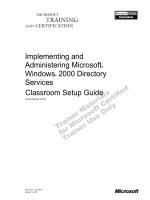Tài liệu Raising and Handling Stored Procedure Errors pptx
Bạn đang xem bản rút gọn của tài liệu. Xem và tải ngay bản đầy đủ của tài liệu tại đây (16.54 KB, 4 trang )
[ Team LiB ]
Recipe 2.10 Raising and Handling Stored Procedure Errors
Problem
You want to catch and handle an error raised from a stored procedure.
Solution
Use a try . . . catch block to catch serious errors. Use the SqlConnection.InfoMessage
event handler to catch informational and warning messages.
The sample code, as shown in Example 2-11
, uses a single stored procedure and two
event handlers:
SP0210_Raiserror
Accepts two input parameters specifying the severity and the state of an error and
raises an error with the specified severity and state.
Raise Error Button.Click
Creates a connection and attaches a handler for warning and information messages
from the SQL Server. A Command is created for the SP0210_Raiserror stored
procedure and the input parameters are defined. The user-specified severity and
state are assigned to the input parameters and the stored procedure command is
executed within a try statement.
SqlConnection.InfoMessage
Called when a warning or informational message is raised by the SQL Server.
Example 2-11. Stored procedure: SP0210_Raiserror
CREATE PROCEDURE SP0210_Raiserror
@Severity int,
@State int = 1
AS
if @Severity>=0 and @Severity <=18
RAISERROR ('Error of severity %d raised from SP 0210_Raiserror.', @Severity,
@State, @Severity)
if @Severity>=19 and @Severity<=25
RAISERROR ('Fatal error of severity %d raised from SP 0210_Raiserror.',
@Severity, @State, @Severity) WITH LOG
RETURN
The C# code is shown in Example 2-12
.
Example 2-12. File: RaiserrorForm.cs
// Namespaces, variables, and constants
using System;
using System.Configuration;
using System.Data;
using System.Data.SqlClient;
// . . .
private void raiseErrorButton_Click(object sender, System.EventArgs e)
{
resultTextBox.Text =
"Severity: " + severityTextBox.Text + Environment.NewLine +
"State: " + stateTextBox.Text + Environment.NewLine +
Environment.NewLine;
// Create the connection.
SqlConnection conn = new SqlConnection(
ConfigurationSettings.AppSettings["Sql_ConnectString"]);
// Attach handler for SqlInfoMessage events.
conn.InfoMessage += new SqlInfoMessageEventHandler(conn_InfoMessage);
// Define a stored procedure command and the parameters.
SqlCommand cmd = new SqlCommand("SP0210_Raiserror", conn);
cmd.CommandType = CommandType.StoredProcedure;
cmd.Parameters.Add("@Severity", SqlDbType.Int);
cmd.Parameters.Add("@State", SqlDbType.Int);
// Set the value for the stored procedure parameters.
cmd.Parameters["@Severity"].Value = severityTextBox.Text;
cmd.Parameters["@State"].Value = stateTextBox.Text;
// Open the connection.
conn.Open( );
try
{
// Try to execute the stored procedure.
cmd.ExecuteNonQuery( );
}
catch(System.Data.SqlClient.SqlException ex)
{
// Catch SqlException errors.
resultTextBox.Text += "ERROR: " + ex.Message;
}
catch(Exception ex)
{
// Catch other errors.
resultTextBox.Text += "OTHER ERROR: " + ex.Message;
}
finally
{
// Close the connection.
conn.Close( );
}
}
private void conn_InfoMessage(object sender, SqlInfoMessageEventArgs e)
{
resultTextBox.Text += "MESSAGE: " + e.Message;
}
Discussion
Errors and messages are returned from a SQL Server stored procedure to a calling
application using the RAISERROR (note the spelling) function. The error message
severity levels are listed in Table 2-12
.
Table 2-12. RAISERROR error message severity levels
Severity level Description
0-10 Informational
11-16 Error which can be corrected by the user
17-19 Resource or system error
20-25 Fatal error indicating a system problem
Severity levels greater than 20 result in the connection being closed.
Since severity levels 10 or less are considered to be informational, they raise a
SqlInfoMessageEvent rather than an error. This is handled by subscribing a
SqlInfoMessageEventHandler to the InfoMessage event of the SqlConnection object.
If the error has severity level 11 or greater, a SqlException is thrown by the SQL Server
.NET data provider.
For more information about the RAISERROR function, look up RAISERROR in SQL
Server Books Online.
[ Team LiB ]









